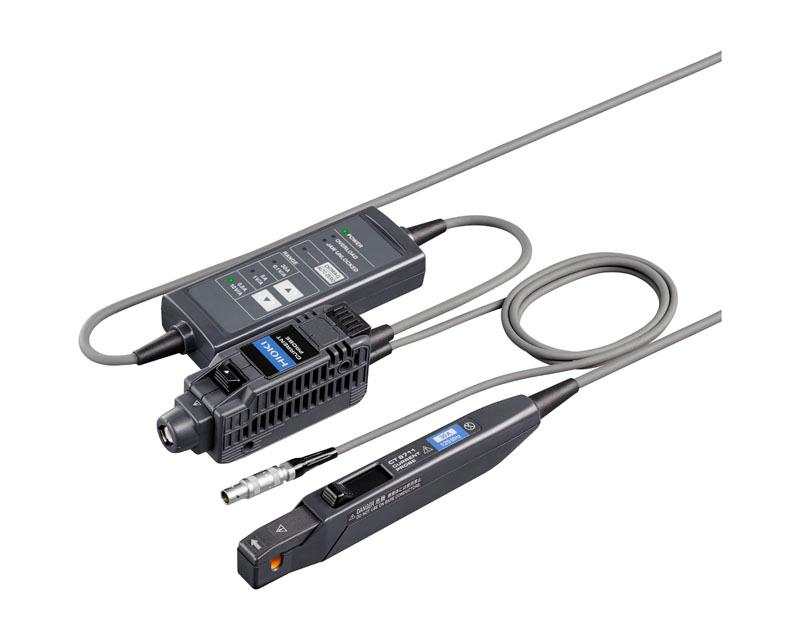 26 April 2019 - HIOKI launched the Current Probes CT6710 and CT6711. Both products provide three ranges (30 A, 5 A, and 0.5 A) to facilitate observation of waveforms representing currents as large as 30 A or as small as several hundred microamperes. This capability makes the probes ideal for observing current waveforms under a variety of operating conditions, including inrush currents, micro currents, and high-speed currents.
26 April 2019 - HIOKI launched the Current Probes CT6710 and CT6711. Both products provide three ranges (30 A, 5 A, and 0.5 A) to facilitate observation of waveforms representing currents as large as 30 A or as small as several hundred microamperes. This capability makes the probes ideal for observing current waveforms under a variety of operating conditions, including inrush currents, micro currents, and high-speed currents.
Current probes convert the current flowing through a wire into a voltage signal. They are connected to data acquisition equipment such as oscilloscopes and Hioki Memory HiCorders so that those devices can display the current waveform, and are used principally in the development and design of products such as electrical and electronic devices, industrial equipment, and electronic components.
Since launching its first clamp-on tester in 1971, HIOKI has developed numerous current sensors for use in a variety of applications. In 2014, the company sought to meet customer demand for high sensitivity by introducing a pair of current probes (the CT6700/CT6701) with 10 times the sensitivity of the legacy models (the 3273/3276). However, the new devices’ current-measuring capabilities were limited by its single range (5 A) configuration even as demand for a single probe capable of measuring both micro and large currents grew. To meet this demand, HIOKI sought to develop a current probe with a wide frequency band (DC to 120 MHz) and a broad measurement range (0.5 A to 30 A).
The new CT6710 and CT6711 provides three ranges (30 A, 5 A, and 0.5 A) so that users can observe a wide range of current waveforms with one device. The result is an instrument capable of accurately identifying currents under various operating conditions, for example by using the 0.5 A range to measure micro currents and the 30 A range to measure inrush currents. In addition, the range can be switched simply by pressing a button on the probe’s relay box.
The CT6710 and CT6711 can observe current waveforms across a wide frequency band, from DC to megahertz bandwidths. With a band of either DC to 50 MHz (CT6710) or DC to 120 MHz (CT6711), the probes accommodate use in an array of settings.
Because they offer higher sensitivity than existing devices, the CT6710 and CT6711 can observe micro currents with a high degree of clarity. The output rate of 1 V/A on the sister products, CT6701 and CT6700, as well as competitive devices means that they generate an output voltage of 1 V for a current value of 1 A. At this low output rate, users need to set the oscilloscope to a high-sensitivity range where noise is more pronounced, resulting in the inability to precisely identify micro currents that are hidden by the noise. By contrast, the CT6710 and CT6711 deliver an output rate of 10 V/A when using the 0.5 A range, giving them 10 times the sensitivity of prior Hioki probes. The higher output rate enables users to make measurements at the low-sensitivity range where noise is less noticeable. Additionally, overall improvements in the probes’ S/N ratio allow use of oscilloscope functionality to observe micro current waveforms with a high degree of clarity.
Connect the CT6710 or CT6711 to an oscilloscope or Memory HiCorder simply by inserting its connector straight into the host instrument’s BNC connector, eliminating the need to rotate to tighten. Additionally, the connector is locked in place automatically so that there’s no need to worry about the sensor accidentally detaching. One-touch disengagement of the locking mechanism makes it easy to disconnect the probe.
www.hioki.com/

 How to resolve AdBlock issue?
How to resolve AdBlock issue? 